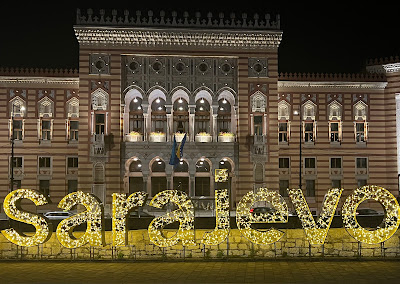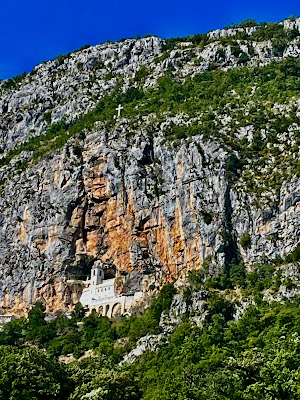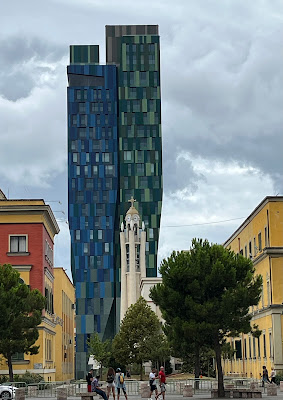For an earlier generation of children, the classic story known as "The Little Engine that Could" - about a small train engine that was able to pull a long train over a high mountain pass after its locomotive failed and other, larger engines gave excuses for not attempting the job - was a lesson in the power of optimism, courage and hard work.
Today's account is not that of this well-known folk tale, but instead is about the real-life little ship, the Handala. But certainly the values of optimism, courage and hard work are equally applicable to the ship and her crew - comprised of human rights activists from around the world sailing in solidarity with Palestine.
In April of this year, I joined the crew of the Handala for the first leg of her voyage as she set sail from Oslo, Norway. The Handala is an 18 metre former fishing vessel from Norway. It is part of the International Freedom Flotilla Coalition (FFC) that has been sailing ships to challenge Israel's illegal and inhuman blockade of Gaza with successive voyages since 2010. As Handala began sailing For the Children of Gaza in April 2023, this is the second year of this campaign. The aims of our present voyage were two-fold. The intended final destination was the besieged and occupied Gaza Strip - presently under near constant bombardment as Israel continues its barbaric, genocidal atrocities against a captive civilian population. The little boat and her small crew aimed high - to challenge and indeed to break the siege of Gaza. Palestinians residing there have been denied all their human rights and have been forced to live under dangerous, inhumane conditions for far too long by a racist, domineering colonial regime. It is time these abhorrent, illegal, dehumanizing conditions come to an end. What our governments refused to do, the crew of our ship to Gaza was intent on accomplishing.
Along the way, sailing to numerous European ports, the second chief goal of our voyage was for the crew to communicate the message that justice and human rights must be upheld for the people of Palestine - especially during this time of great pain, sorrow and trauma. We demanded an immediate, permanent ceasefire and voiced loud and clearly the obvious imperative to stop the genocide. With these goals in mind, we took part in press conferences, made presentations and participated in large-scale demonstrations in all the cities we visited.
As children comprise nearly half the population of Gaza, and who because of their fragile, developing minds and bodies are especially vulnerable to suffer life-altering physical and psychological scars from the massive political violence they are endlessly subjected to, the Handala centered its focus on the urgent need to protect Palestinian children. For this reason, the mission for the Handala was named "For the Children of Gaza". Our aims, broadly speaking were thus to facilitate much-needed social and political change by both public education about the plight of children in Gaza, and to insist that our governments uphold their obligations under international law and demand that Israel end it's siege on Gaza.
2024 saw two international missions of the Freedom Flotilla Coalition. The first and larger project is named, "Break the Siege" and it is the Emergency Humanitarian Aid Mission. Multiple aid vessels with hundreds of human rights observers carrying 5,000 tons of humanitarian aid were to set sale from Istanbul in April 2024. Unfortunately amidst the deadly siege and ongoing genocide in Gaza, forces backing Israel and simultaneously in complete disregard of the besieged, bombarded, starving Palestinians prevailed; the ship was not permitted to sail from Turkey to Gaza. Shame!
The second FCC mission was that of the Handala. Her mission, as articulated above was to highlight the catastrophic impacts of the siege, occupation and genocide on the lives of Palestinian children. Both Missions are part of the long-standing, international maritime campaign whose aim is to deliver aid and challenge Israel's illegal, inhumane and deadly 17 year-long blockade.
The ship I sailed on is named after Naji Al-Ali's well-known political cartoon character, Handala. Handala is a ten year-old Palestinian refugee child who always stands with his back to the viewer. This resilient and resourceful child is representational of all Palestinians who were forcibly displaced by Israel's settler colonial project. This dispossessed, yet determined and feisty child will turn round to face us only when he's finally able to return to the home country he was driven out of. To this day, Palestinian refugees and their descendants are not permitted by Israeli occupation forces to return to the homes they were forcefully expelled from. Jewish colonizers from around the world, on the other hand are not only permitted unfettered access to historic Palestine, but these so-called "settlers" are encouraged with financial incentives to move into illegal, Jewish-only, militarily protected colonies on stolen Palestinian land. Shame!
For me, perhaps the most gratifying and meaningful aspect of our solidarity voyage were the small interactions I had with people who greeted us at the various ports of call. The joy and appreciation they conveyed in response to being unconditionally accepted as precious human beings and whose inherent dignity was upheld and embraced was something I'll never forget. For example, this one episode provided sufficient validation to know just how important our voyage truly was. A group of children came up to me in Bremerhaven, Germany with a bottle filled with messages and drawings they had made and asked us to toss it into the sea as we approach Gaza. They told me how they hoped that children there can understand that they too are loved and not abandoned by the outside world! The innocence and kindness of this lovely solidarity action is inspirational and unforgettable.
After a large and energetic send-off at the pier in Oslo, we sailed to Gothenburg, Helsinborg and onto Malmö, Sweden. The timing of our arrival in Malmö was especially fruitful as it coincided with the massive public outcry against the organizers of Eurovision for permitting Israel to participate in this year's music contest and festival taking place there at the same time that Israel was slaughtering tens of thousands of innocent people in Gaza. How in the world can an event celebrating dance, music and merriment include members of an apartheid state perpetrating brutal war crimes? We joined thousands of activists and marched in the streets with our Ship to Gaza flags to lend our voices to the collective outrage. Our energetic celebration of life and liberty vigorously protested the obscenity of associating music with political violence and mass murder.
An arresting performance greeted our crew at the Malmö dock as we were tying up. A young troupe of Palestinian actors brought to life some of the horrific events unfolding in Gaza, including a recording of a report by the now familiar voice of the young Palestinian videographer and journalist, Bisan Owda, whose personal Instagram reports powerfully document daily life in Gaza. Recently she was nominated for an Emmy Award - despite efforts by a Zionist campaign to have her get barred from the competition for the usual and entirely absurd allegation that reporting crimes against humanity is somehow antisemitic. One astonishing scene in their performance left me in tears, while at the same time reinforced why our mission is of of such importance, especially at this time of unparalleled urgency. Following a disturbing enactment of an aerial bombardment, we see that a little girl has been killed by an Israeli bomb that shattered her home. Her father, stunned by inconsolable grief, is seen carrying the small body wrapped in a white shroud. The martyred girl's spirit unexpectedly appears to the weeping father and she comforts him saying that here in heaven everything is peaceful and beautiful, that she is not in pain, nor is she afraid. "Please, Papa, don't be sad."
It wasn't until we sailed into Germany that we encountered any hostility and negativity from the authorities. The contrast between the joyous greeting and collective, loving embrace we felt from the people of Bremerhaven, Germany and the rigid police reaction to us was stark and disturbing. The German government has made unconditional support for Israel to be a matter of "Staatsräson" or "reason of state". This rigid, fascistic attitude is central to the country's core identity due to its unresolved collective guilt stemming from the country's genocidal actions against Jews in World War ll. That the same state is now paradoxically giving diplomatic and material support for another genocide - this time committed by Israel, seems not to matter to those in power. We were told that the phrase "From the River to the Sea, Palestine Will be Free" incorporated into a mural on the starboard side of the Handala was strictly illegal in Germany. We were ordered to remove it or risk getting arrested. Explaining that we simply couldn't paint over the entire side of our ship for a two-day stay in port, we agreed upon a compromise - to cover up the criminalized liberation slogan. In the end, a small victory of sorts was ours in that we covered-up the phrase with a large Palestinian flag!
Seeing the joy we brought to the local Palestinian community was heartwarming and reciprocal. Being a Palestinian and living under an insanely one-sided, dehumanizing, pro-Zionist political framework, one can easily imagine how happy people were to see us sail into their harbour conveying loving kindness, compassionate acceptance and political solidarity. One evening, the crew left the boat to have dinner in town and I was the only one onboard to tend to Handala. Before long, at least fifty locals came to visit the ship for an impromptu party. The people brought musical instruments and delicious food. We danced. Children sang. We chanted liberation slogans. The spontaneous outpouring of cultural pride and community reminded me once again, that the "little ship that could" was fulfilling her mission in countless, at times entirely unpredictable and happy ways.
I left the ship in Germany after two weeks of sailing in Norway, Sweden, Denmark and Germany. A new crew of beautiful, dedicated, compassionate, peace and justice-driven, Palestine solidarity, human rights activists from nations around the world again came aboard the Handala as she continued to sail to more than twenty-five ports in Europe before reaching Malta.
Regrettably it was necessary for the Handala to temporarily end her voyage in Malta in late August of 2024. It was felt that the aging fishing vessel was no longer able to safely navigate the treacherous waters between Malta and Gaza. Both 2024 missions of the international Freedom Flotilla Coalition, "For the Children of Gaza" and "Break the Siege" have thus temporarily been delayed before completing their respective missions. This does not at all mean that the "little ship that could" - could not - only that for safety and out of logistic necessity, she and her larger sibling vessels have needed to regroup before heading out again.
The goal remains - End the Siege on Gaza! Stop the Genocide! Free Palestine! When the time is right, I'm ready to set sail again!






































